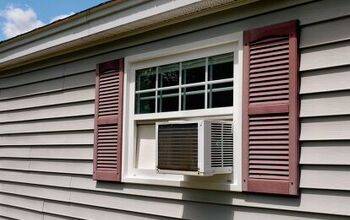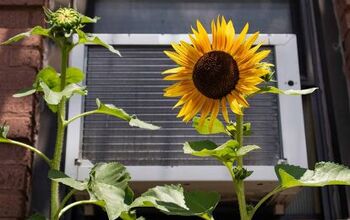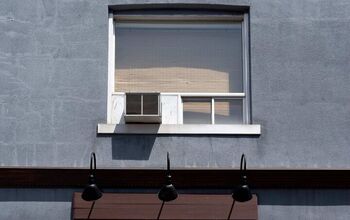Can A Window Air Conditioner Be Installed In A Wall Sleeve?

Window mounted refrigerated air conditioning units are popular when a bit of extra cooling power is needed. Window mounted air conditioners are easy to install and economical. But, what if there is no window in the space you want to cool? Can you install a window air conditioner unit through a wall sleeve?
Can a window air conditioner be installed in a wall sleeve? The design of the average window air conditioner is not suitable for mounting through a wall using a wall sleeve. Typical window air conditioning units vent to the sides and not out the back. A wall sleeve can prevent the air conditioner from venting correctly.
Understanding the difference in window-mounted air conditioners and those made to fit through a wall make this clear. It is vital that you properly mount the unit to prevent damaging the window-mounted air conditioner. The air conditioner must have clear avenues of ventilation.
Do You Need a Window A/C Unit Installed?
Get free, zero-commitment quotes from pro contractors near you.

What is the Major Difference in a Window-Mount and a Through-The-Wall Mount?
Looking at air conditioners at the store can be confusing. Window-mounted units and through the wall units can be hard to tell apart. Without reading the box carefully, two units may look identical but require completely different mounting strategies.
In general, window-mount air conditioner designs adapt to the thinner spacing of a window rather than the width of a wall. Internally, window-mount air conditioners vent to the side. Side venting puts the vent closer to the condensing unit that generates the most heat.
The Problems with a Wall Sleeve and a Window-Mount Air Conditioner
Fitting a window-mount air conditioner through a wall sleeve often partially blocks the side vents. A partial blockage reduces the amount of airflow through the inside of the air conditioner. Reduced airflow equals increased heat. Heat build-up internally can be deadly for an air conditioner.
How the Mounts Differ – It’s All About the Seal
There are several significant problems that you will encounter trying to install a window mount air conditioner through the wall. In the long run, if you need a through-wall installation, it is better to purchase a through-wall mount air-conditioner
The Window Mount – Designed for Windows
A window-mount air conditioner comes with the parts and mounts to put the unit in the proper place. Windows are thinner than wall structures. The adapters and mounts included with window-mount air conditioners can create a tight seal in the window.
These mounts and adapters cannot retrofit into a wall opening or an air conditioner sleeve. Trying to make a window mount air conditioner fit has several failure points to consider.
- Window-mount units don’t come with the necessary hardware to fit into a wall. Though-wall air conditioners slip into a sleeve mounted into the opening. The air conditioner unit slips into the sleeve where and seals against the weather.
- If you do get a window-mount unit installed and sealed, how will you remove it down the line when it needs repair or replacement.
- Maintenance like cleaning and filter replacement may be impossible when a window-mount air conditioner mounts through the wall.
Through the Wall Mounts – More Trouble and More Expense
Opting for a through the wall mount air conditioner usually means more expense and more trouble. In most instances, you need the services of a professional installer. Opening a hole in your exterior wall can be a challenge.
Dealing with The Exterior
Opening the proper size hole in the exterior of your home is one big hurdle. If your home has traditional wood siding, it may not be as difficult. Brick veneer or a masonry exterior wall can pose challenges that most home do-it-yourselfers can’t handle. Other unseen problems may lurk in the walls to complicate the job.
- Electrical wiring that may run through the desired opening site
- Plumbing that may exist within the wall
- Structural requirements that may need additional framing
Before opening an exterior wall, you should be confident that you can deal with one of these hazards. Moving plumbing or electrical lines can be expensive and dangerous.
Interior Finish Issues – Making it Look Good
Finishing the opening around the through the wall installation is as important as the other consideration. The trim around the opening is part of the process of sealing the opening against drafts and weather. If you make an incorrect opening, it may be impossible to trim. Poor-fitting trim is not only unattractive, it is inefficient.
Other Options for Through-the-Wall Installations
What if you don’t have a window for a window-mount installation? The thought of opening an exterior wall can be overwhelming as well and expensive. Fortunately, there are alternatives.
Mini-Split Systems
With the convenience of a central HVAC and much easier installation, a mini-split system may solve your problems. These systems have an outdoor unit and an indoor unit connected by the refrigerant lines.
This split design allows you to put the condensing unit outside and hang the coil and fan unit on the wall inside. A small hole in the exterior wall for the refrigerant lines is all that is required. There is no ductwork to worry with as well.
These mini-systems are not much more expensive than through the wall air conditioning unit. These new air conditioners are much more efficient and effective in the long run.
In-Room Portable Air Conditioners
A variant on window air conditioner units is the in-room portable air conditioner. These units use the same type of cooling design. The difference is that the equipment sits inside the room. The air used to cool the condenser comes from outside through a small vent pipe and then sent back outside.
This vent is usually a 4-inch flexible duct. The duct fits an adapter that attaches into a window. A through the wall fitting, much like a dryer vent, is available. The through the wall fitting requires much less work to install.
Which is Better – Window Mount or Through-the-Wall?
Each type of air conditioner has its pros and cons. To mention just a few
Pros
- Window units are easier to install
- The cost of window units is typically cheaper than comparable through the wall units
- Through the wall units tend to be more efficient
- Window units are relatively easy to move
- You don’t lose a window with a through the wall unit
- The longer operational life of most through-the-wall units is a plus
Cons
- Window units are often noisier than through the wall units
- Some people don’t like the look of a window unit
- You lose a window when you install a window mount air conditioner
- Window units are considered short term solutions to cooling problems
- Through the wall units require considerable expense to install properly
- If you have a large area to cool, a through the wall unit may not be able to meet the requirements.
Do You Need a Window A/C Unit Installed?
Get free, zero-commitment quotes from pro contractors near you.

Making the Choice – Window Mount or Wall Mount
Whichever option you choose, the critical thing to remember is that a window mount air conditioner should not be used in a through the wall mount sleeve. The air conditioner may look like a good fit and operate initially. In the long run, the difference in vent locations may spell an early demise for the air conditioner unit.
It is always better to choose the proper air conditioner for the job and installation than try to make a cheaper alternative work. Over time, it will be less expensive and create fewer frustrations.
Related Guides

We are a team of passionate homeowners, home improvement pros, and DIY enthusiasts who enjoy sharing home improvement, housekeeping, decorating, and more with other homeowners! Whether you're looking for a step-by-step guide on fixing an appliance or the cost of installing a fence, we've here to help.
More by Upgraded Home Team



























